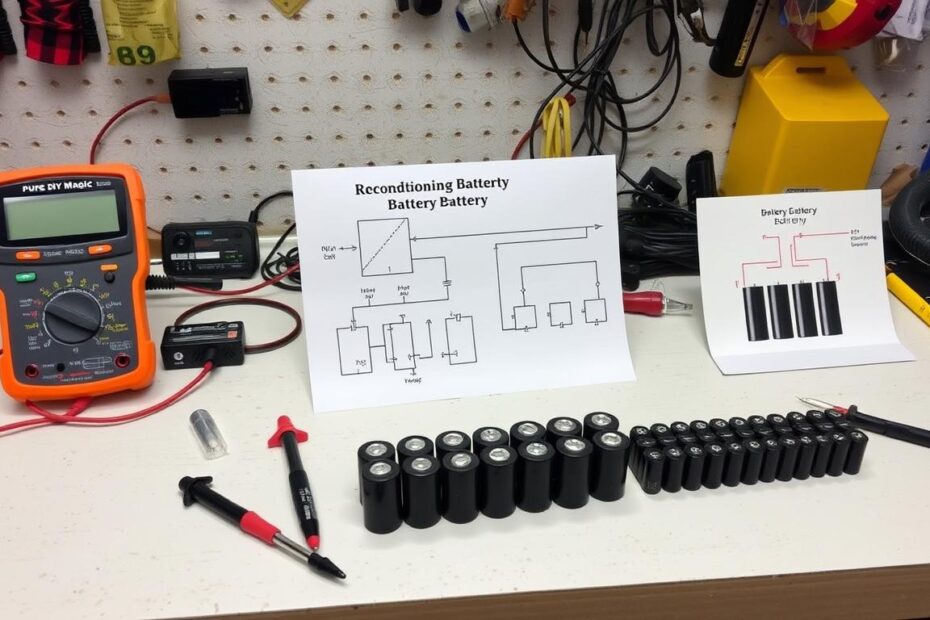Ever thought about reviving old, dead Nickel-Cadmium (NiCad) batteries? The good news is, you can. With the right methods, you can breathe new life into them. This saves you money over time.
This guide will show you how to recondition NiCad batteries. We’ll cover everything from common issues to the tools and safety gear you need. By the end, you’ll know how to keep your NiCad batteries working well for years.
Key Takeaways
- Discover the secrets to reviving old, seemingly dead NiCad batteries
- Learn the common issues that plague NiCad batteries and how to address them
- Understand the science behind the reconditioning process and its impact on battery life
- Gain the essential tools and safety knowledge to recondition your batteries safely
- Explore alternative methods for battery revival and maintenance tips for longevity
But first, let’s answer a big question: Can you really restore a NiCad battery to its former glory, or is it just a myth? Let’s find out the truth. We’ll explore how to unlock your NiCad batteries’ full potential.
Understanding NiCad Batteries and Their Common Issues
Nickel-cadmium (NiCad) batteries are known for their durability and reliable performance. They power many devices. But, they can face common issues that affect their lifespan and performance. Knowing about NiCad batteries and signs of wear is key for their care and maintenance.
Components of Nickel-Cadmium Batteries
NiCad batteries have three main parts: the cathode, anode, and electrolyte. The cathode is nickel oxyhydroxide, and the anode is cadmium. The electrolyte is a potassium hydroxide solution that helps ions flow between the parts.
Signs of Battery Degradation
- Reduced battery capacity: NiCad batteries can lose their charge-holding ability over time. This means they need to be charged more often.
- Voltage depression: As batteries age, their voltage can drop. This can harm the device’s performance.
- Increased self-discharge: Older NiCad batteries discharge faster. They need more frequent recharging.
Memory Effect Explained
The memory effect is a big issue with NiCad batteries. It happens when the battery is charged before it’s fully used. This makes the battery remember the shorter charge cycle. It can’t reach its full capacity anymore. Regular deep discharges help avoid this and keep your batteries working longer.
“Understanding the components and common issues of NiCad batteries is the first step towards effective battery maintenance and revival.”
Essential Tools and Safety Equipment for Battery Reconditioning
Reconditioning nickel-cadmium (NiCad) batteries needs the right tools and safety gear. It makes sure the process works well and keeps you safe from battery dangers. Here are the key items for safe and effective NiCad battery reconditioning.
Necessary Tools
- Voltmeter: This device lets you check the voltage of each battery cell. It helps spot any problems or imbalances.
- Battery Analyzer: A battery analyzer gives detailed info on the battery’s capacity, charge level, and health. It guides you through the reconditioning steps.
- Battery Charger: Use a charger made for NiCad batteries. It ensures the battery is charged and discharged correctly during reconditioning.
Protective Safety Gear
- Rubber Gloves: Wear gloves to avoid touching battery acid and electrolyte.
- Safety Goggles: Keep your eyes safe from splashes or accidents when handling batteries.
- Apron or Coveralls: Wear an apron or coveralls to keep your clothes clean and prevent battery residue spread.
Also, make sure your work area is well-ventilated. This reduces the risk of inhaling fumes or gases during reconditioning. By taking these precautions, you can safely and effectively recondition your NiCad batteries. This extends their life and saves you money on replacements.
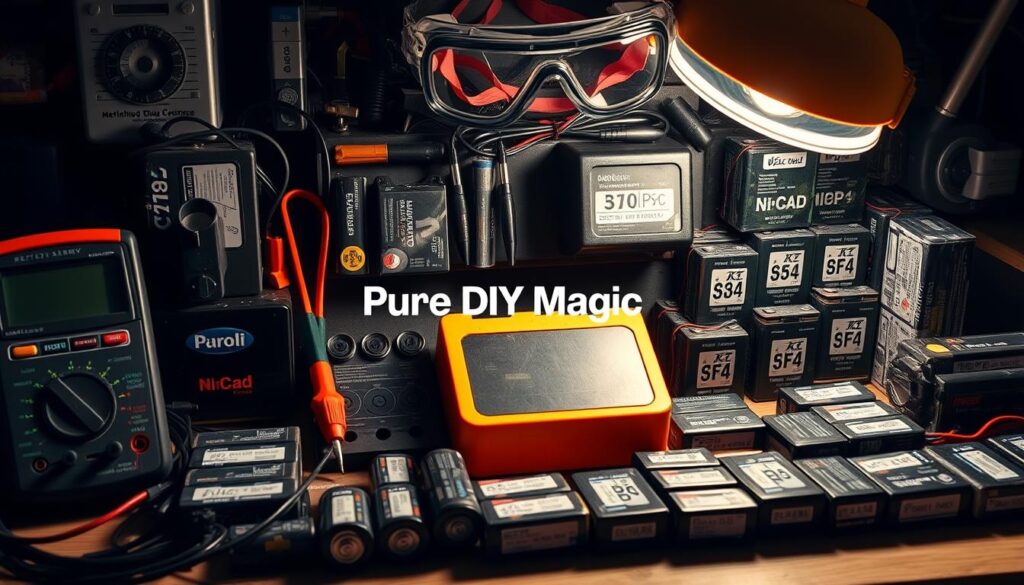
“Proper safety equipment is the foundation of a successful battery reconditioning project. Never compromise on your personal protection.”
The Science Behind Reconditioning NiCad Batteries
Exploring the science of NiCad battery reconditioning shows us the complex chemical and cell structure dynamics. This knowledge helps us understand why the nicad rejuvenation process works so well in bringing back life to dead batteries.
Chemical Processes During Reconditioning
The reconditioning process involves a deep discharge cycle. This cycle starts a series of chemical reactions in the cells. These reactions help break down the crystalline structures on the electrodes, known as the “memory effect.”
This effect can reduce a battery’s capacity. By breaking these formations, the battery can once again hold a full charge.
Battery Cell Structure and Function
NiCad batteries have many cells, each with a positive electrode (nickel oxide hydroxide), a negative electrode (cadmium), and an electrolyte solution. When in use, these components react to produce electrical current for your devices.
Knowing how these parts work is key to restoring the battery’s capacity through reconditioning.
Understanding Voltage Recovery
As the battery is cycled through discharge and recharge during reconditioning, its voltage stabilizes and recovers. This recovery is a sign of the battery’s health and its ability to hold a charge.
By watching the voltage during reconditioning, you can see if the battery is getting back to its best performance and capacity.
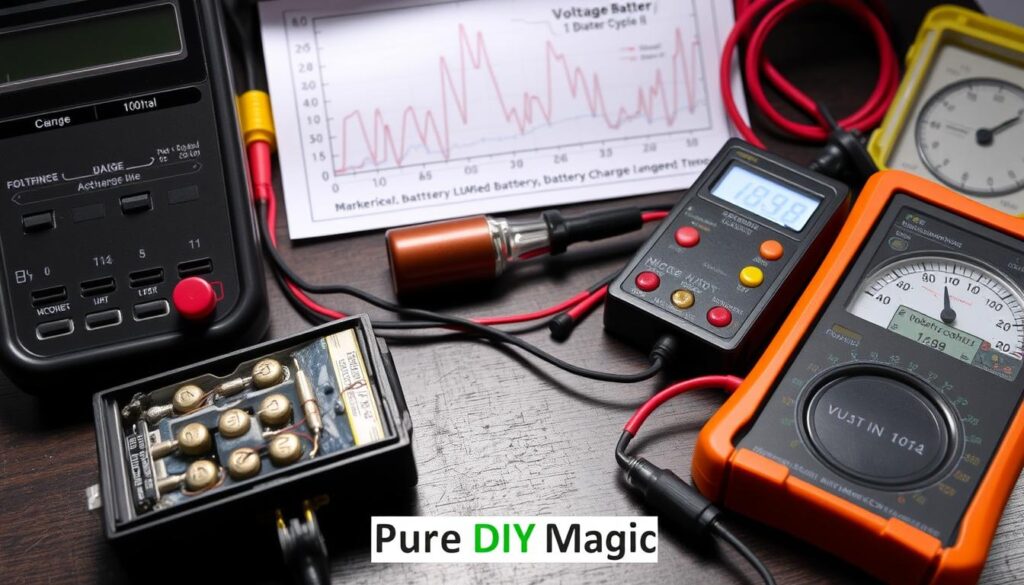
Preparing Your Workspace for Battery Reconditioning
Setting up your workspace right is key for battery maintenance and nickel-cadmium battery care. A safe, organized, and efficient space will improve your work quality and lower risks. Let’s look at what you need for a good workspace.
First, make sure your work area has good ventilation. Nickel-cadmium batteries can release hydrogen gas, which is flammable. Good airflow helps prevent gas buildup, keeping your space safe from explosions or fires.
Being organized is crucial for a smooth reconditioning process. Arrange your tools and materials so they’re easy to find. This makes your work faster and reduces the chance of losing important items.
- Choose a clean, well-lit area for your battery reconditioning tasks.
- Have all your tools, like voltmeters and chargers, organized on your workbench.
- Make sure you have protective gear, like safety goggles and gloves, and a fire extinguisher nearby.
Lastly, think about the overall safety of your workspace. Keep it clear of clutter and make sure the surface can hold the weight of the batteries. A clean space prevents accidents and tripping hazards.
“Preparation is the key to success, and this couldn’t be truer when it comes to battery reconditioning.”
By setting up your workspace correctly, you’re on the path to a successful battery maintenance and nickel-cadmium battery care journey. A bit of attention to detail can make your reconditioning process safer and more efficient.
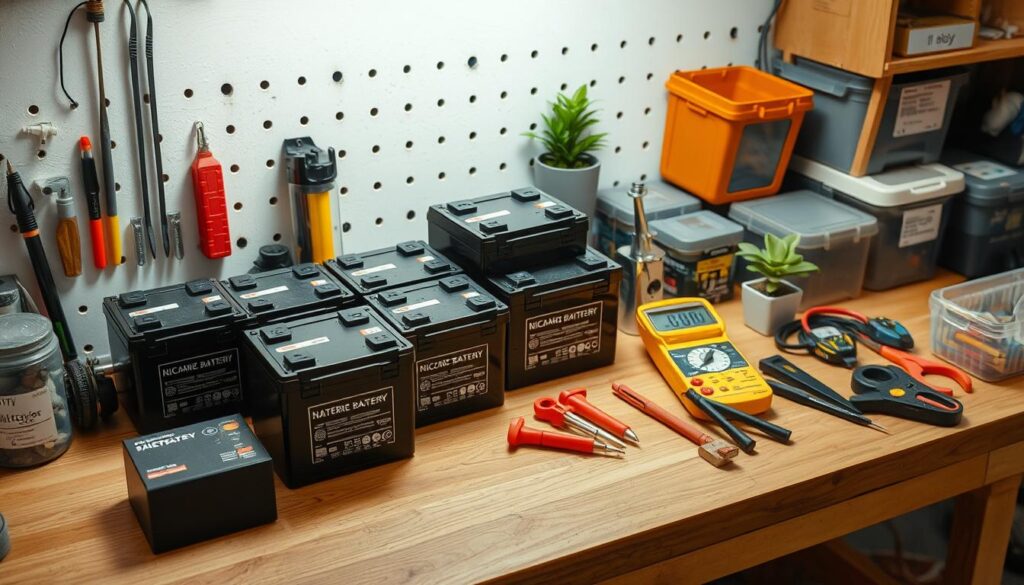
Step-by-Step Guide to Reconditioning NiCad Batteries
Reviving your nickel-cadmium (NiCad) batteries is easy and rewarding. By reconditioning, you can make them last longer and recoup their lost capacity. Follow this guide to learn how to recondition NiCad batteries and extend battery life.
Initial Battery Assessment
Start by checking your NiCad batteries for damage. Look for cracks or leaks. Use a voltmeter to check each cell’s voltage. If some cells have much lower voltage, they might need extra care.
Deep Discharge Process
- Drain the batteries completely by using them until they’re empty.
- This step breaks down crystals in the cells, known as “memory effect.”
- Removing these crystals helps the battery hold a full charge again.
Charging Cycle Methods
- Once discharged, recharge the batteries with a NiCad charger. Do this in a series of cycles.
- These cycles improve the battery’s performance and extend its life.
- Watch the charging closely and follow the charger’s instructions for the best results.
By following these steps to recondition NiCad batteries, you can make them work better. Always be safe and follow the maker’s advice for the best results.
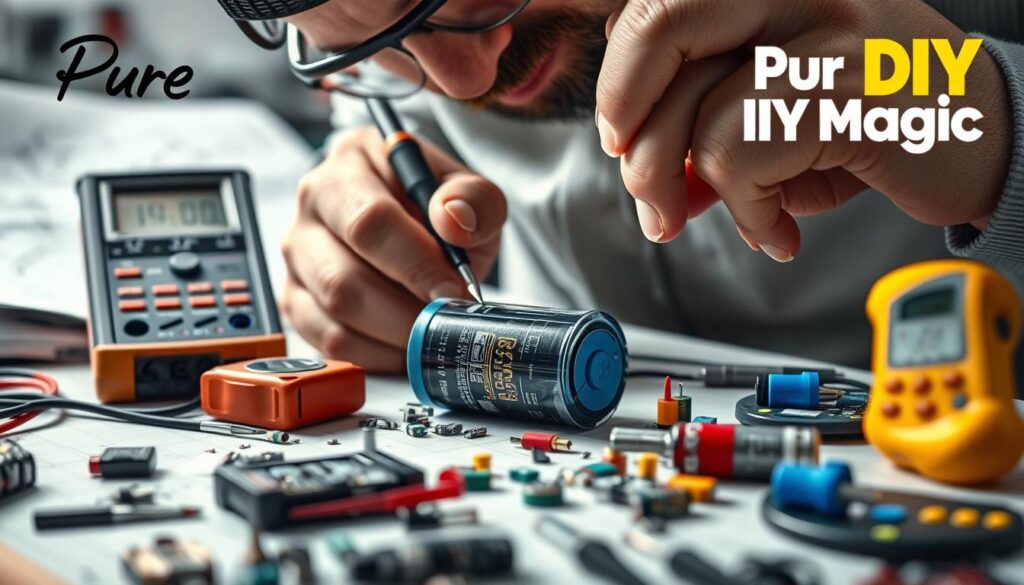
Alternative Methods for Battery Revival
If nicad reconditioning methods don’t work, you can try other ways to revive old batteries. Techniques like zapping, pulse charging, and using chemical additives might help. They can give new life to old NiCad batteries.
Zapping uses a high-voltage, short electrical pulse to the battery. This shock can break down discharge crystals, possibly restoring battery capacity. But, it must be done carefully to avoid harming the cells.
- Pulse charging sends short, high-current charges to the battery. It can fight the memory effect and boost battery performance.
- Chemical additives, like special battery conditioners, can dissolve corrosion and contaminants. They might work, but their long-term effects are not always clear.
Remember, these methods might not work as well as standard nicad reconditioning methods. They should be used with caution and alongside other methods. Always check the manufacturer’s instructions before trying these alternatives to revive old batteries.
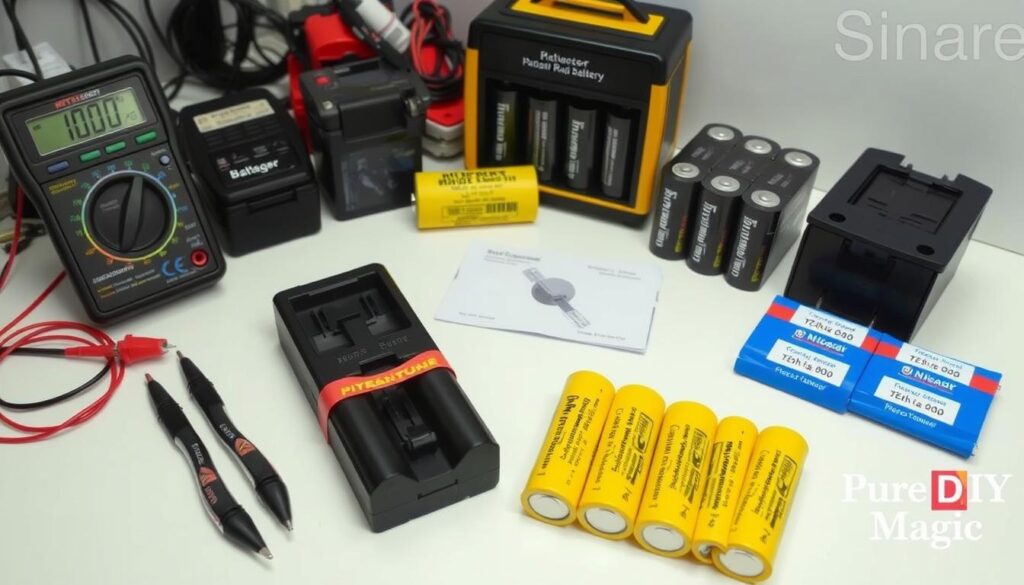
“The key to successful battery revival is understanding the unique characteristics and limitations of each method, and applying them judiciously to achieve the best results.”
Maintaining Reconditioned Batteries for Longevity
Keeping your reconditioned nickel-cadmium (NiCad) batteries in good shape is key. By following some simple steps, you can make sure they last a long time. This way, you’ll get reliable power for your devices for years.
Proper Storage Techniques
When you store your NiCad batteries, keep them away from extreme heat, moisture, and sunlight. Store them in a cool, dry spot, like a room temperature area. This helps prevent damage and keeps them ready to use when you need them.
Charging Best Practices
Charging your NiCad batteries right is important for their life. Don’t overcharge them, as it can cause damage. Instead, charge them according to the maker’s instructions and use a charger made for NiCad batteries. Also, doing a full discharge and recharge cycle now and then keeps them working well.
- Charge NiCad batteries at the recommended current and voltage levels
- Avoid leaving batteries on the charger for extended periods after they are fully charged
- Regularly perform a full discharge and recharge cycle to calibrate the battery
By storing and charging your NiCad batteries correctly, you can make them last longer. This means you’ll have reliable power for your devices for many years.
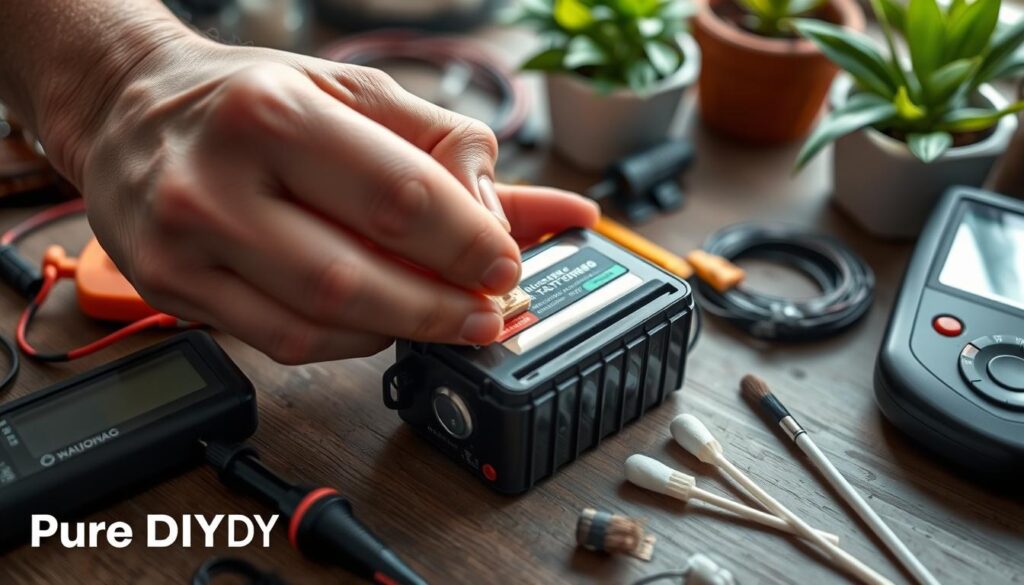
“Proper battery care is the key to maximizing the lifespan of your reconditioned NiCad batteries.”
Troubleshooting Common Problems During Reconditioning
Starting the nicad rejuvenation process can sometimes hit unexpected bumps. When you’re trying to bring back life to old batteries, you need to be ready for any problems. Here, we’ll look at common issues and offer solutions to help you fix them.
Battery Not Holding a Charge
If your battery won’t hold a charge, there could be a few reasons. Make sure the battery has fully discharged and charged again. If it still doesn’t work, the cells might be damaged beyond repair. You might need to replace them.
Testing each cell can help find out which ones are the problem.
Unusual Heating During Charging
Too much heat while charging is a bad sign. It could mean a short circuit in the battery or a charger problem. Stop charging right away and check the battery and charger for damage or malfunctions.
Failure to Recover Capacity
- If your battery can’t get back to its original power after reconditioning, it might be too old. Try deep discharging and charging a few times to see if it helps.
- If it still doesn’t work, the cells might be too worn out and need to be replaced.
Fixing common problems in reconditioning takes patience and careful attention. By tackling these issues, you can bring your batteries back to life.

Environmental Benefits of Battery Reconditioning
Reconditioning your NiCad batteries extends their life and helps the environment. It cuts down on the need for new batteries. This means less electronic waste and more resources saved.
Reducing Electronic Waste
Reconditioning keeps batteries out of landfills and incinerators. These places harm our environment with toxic chemicals. Reused batteries reduce the need for new ones, lowering environmental harm.
Cost Savings Analysis
Reconditioning saves money compared to buying new batteries. It takes less time and money than buying new ones. This makes it a smart choice for saving money.
| Cost Comparison | Reconditioned Batteries | New Batteries |
|---|---|---|
| Average Cost per Battery | $5 | $15 |
| Cost Savings per Battery | – | $10 |
| Estimated Lifespan | 2-3 years | 1-2 years |
Using battery recycling techniques and extending battery life through reconditioning helps the planet. It also saves you money in the long run. This simple method benefits your wallet and the environment.
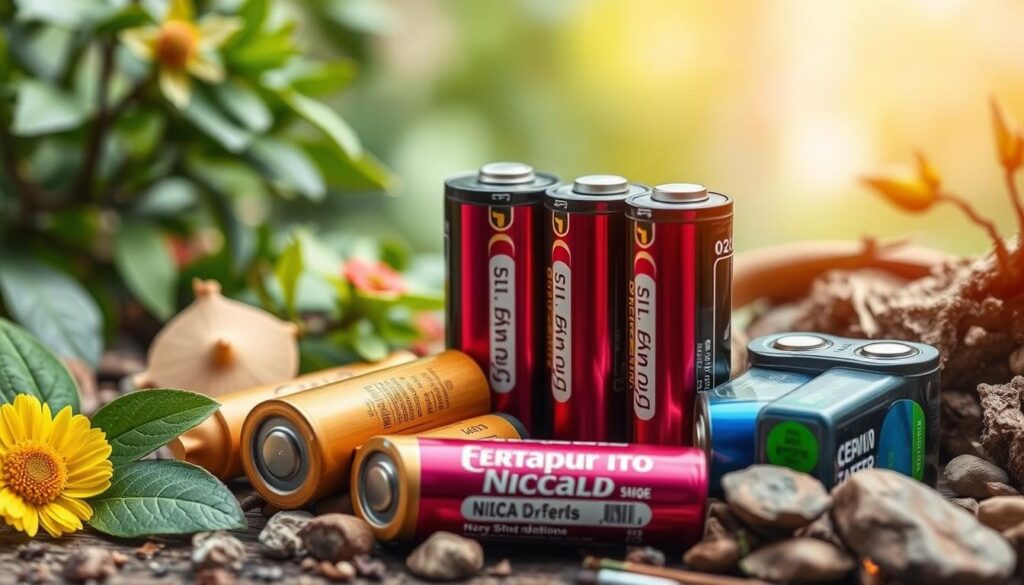
When to Replace Instead of Recondition
For nickel-cadmium (NiCad) batteries, there’s a point where reconditioning won’t work anymore. It’s time to replace them. Knowing when a battery is beyond repair is key to keeping your devices working well and safely.
A big drop in battery capacity and runtime is a clear sign it’s time to replace. If your battery can’t hold a charge or lasts much less time, it’s likely time for a new one.
Another important thing to think about is safety. If your battery looks damaged, like it’s swelling, leaking, or changing color, get rid of it fast. This is to avoid fires or explosions.
| Replacement Criteria | Recondition Viable |
|---|---|
| Significant capacity loss | ✓ |
| Physical damage (swelling, leakage, discoloration) | ✘ |
| Inability to hold a charge | ✘ |
| Repeated failure during reconditioning process | ✘ |
When you can’t recondition a battery anymore, it’s important to get rid of it right. Many places and stores have recycling programs for old batteries. This makes sure the harmful stuff is handled safely and doesn’t harm the environment.
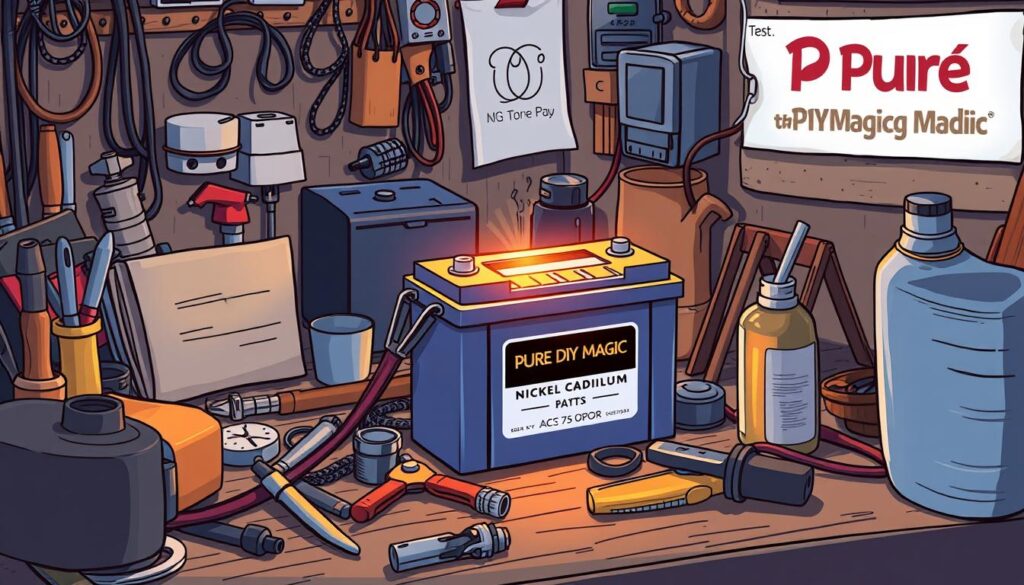
Knowing when a NiCad battery needs to be replaced helps your devices work better. It also helps the planet by recycling batteries properly.
Conclusion
In this guide, we’ve delved into the world of reconditioning NiCad batteries. We’ve shown how to unlock their full potential and extend their life. Now, you know how to give new life to your rechargeable devices.
The steps we’ve outlined give you the tools to recondition your NiCad batteries well. You can revive even the most worn-out batteries. This way, you’ll enjoy their performance like new.
Keeping your reconditioned batteries in good shape is crucial. Proper storage and charging are key. By following the best practices, your batteries will last longer. This helps reduce electronic waste and supports a sustainable future.
FAQ
What is the purpose of reconditioning NiCad batteries?
Reconditioning NiCad batteries brings old batteries back to life. It restores their power and extends their use. This saves money and reduces waste by letting you use your batteries longer.
What are the common issues with NiCad batteries?
NiCad batteries often lose power and voltage over time. They also suffer from the memory effect. This means they can’t fully charge if they’ve been partially used before.
What tools and safety equipment are needed for battery reconditioning?
You’ll need a voltmeter, a battery analyzer, and safety gear like gloves and goggles. Make sure you work in a well-ventilated area for safety.
How does the reconditioning process work for NiCad batteries?
The process starts with checking the battery’s health. Then, it’s deeply discharged and charged in a controlled way. This helps restore its power and voltage.
Are there alternative methods for reviving NiCad batteries?
Yes, methods like zapping and pulse charging can revive batteries. Chemical additives are also used. But, their success can vary, so it’s key to research them well.
How can I maintain reconditioned NiCad batteries for optimal longevity?
Keep them cool and dry to extend their life. Also, charge them correctly to avoid overcharging. This helps them last longer.
When should I replace NiCad batteries instead of reconditioning them?
Replace batteries if they’re damaged beyond repair or if they’re no longer safe. Also, if they can’t be reconditioned effectively, it’s time for a new one.
